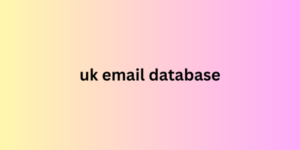What are we talking about?
A framework can be called a skeleton — a base on which the process of creating an application is built. Few people are interested in doing the same work over and over again. Frameworks provide a set of tools that can significantly speed up the development process. A kind of template. If you have already tried zero coding, for example, creating a website on Tilda, this will definitely be familiar to you. And if you haven't tried it yet, you can start with a free webinar — the best introductory mini-course for future no-code developers!
Frameworks are based on programming uk email database languages. Accordingly, before you start working with a "framework", you first need to learn the base. For example, you like Angular, but you definitely shouldn't study it without the "mother" language JavaScript. Usually, developers first get basic knowledge of a programming language, and then start learning frameworks: this is both more logical and easier.
Frameworks are most in demand in website and application development, and also in data science. Each offers its own range of tools and capabilities.
Main types
In addition to dividing into types depending on the programming language in which the frameworks are written, they can also be divided into classes by functionality. For example, when it comes to tools for developing web applications and sites, they can be:

frontend frameworks: Angular, Vue.js, Bootstrap and others. Their main task is to create a convenient and beautiful user interface, the side of the application that the client sees. Frontend developers, for obvious reasons, choose them;
backend frameworks: Ruby on Rails, Django, Spring Boot and others. They are used to build the side of the application that clients usually don't see, but which is very important. These tools help connect APIs and databases to the application, and interact with requests.
Mobile development frameworks stand apart: Flutter, React, Ionic, and others. They help build mobile applications for iOS and Android.
Finally, there are data science frameworks. Their task is to help the user collect information from different sources, and then analyze it using statistics and various algorithms. Examples: PyTorch and Apache Spark. Although, given that the most popular language for data science is Python, most frameworks are written in it.
Why are frameworks so popular?
As humanity, we strive to make our lives easier and more interesting. That is why neural networks and automation are becoming more and more popular every year. They take routine tasks off our shoulders, leaving us with creativity and creativity - what we were originally designed for.
Frameworks appeared for the same reason — they make code cleaner, reduce the risk of errors, simplify debugging, and generally make the developer's work easier. It becomes easier for other coders to understand and refine tasks on someone else's legacy code. Therefore, immediately after learning "vanilla" JavaScript, many front-enders receive specialization in one or more frameworks — React, Vue, Angular. With such anamnesis, it also becomes easier to find a job.
Benefits of frameworks in development:
the process of testing and debugging code is simplified;
the code becomes cleaner - it is easier for other coders to understand it;
the amount of redundant code in the project is reduced;
the amount of time spent on a project is reduced, which means its cost is reduced.
And in general, you don’t have to start a project from scratch. Many frameworks offer templates that you can use as a starting point. Bootstrap is absolutely irreplaceable in the modern world of frontend.
Framework vs. Library
Frameworks are sometimes called "libraries" in the development environment, but these are not synonymous concepts. A library is part of a framework - one of the tools you can work with.
A library consists of components that solve a specific problem, while a framework can consist of different libraries. You could say that a framework is a kind of multi-tool, while a library is a conventional hammer, screwdriver or saw.
Frameworks provide developers with a complete environment of various tools and functionalities. They allow you to work on the logic of the application, rather than focusing on small details and writing basic f